Christmas Trains
Greetings!
The tradition of having a model train running around the Christmas tree allegedly started in the Baltimore, MD, area in the late 1800s. Last Christmas Ruthi and I decided to revive the custom, using one of her Lego trains.
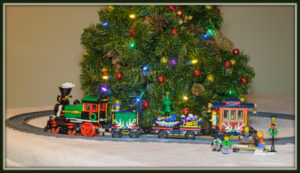
The train was very small, but then so was our Christmas tree – in fact it sat on top of the (suitably protected) piano!
I was certainly not aware of the custom when I was growing up in England. At that time (basically the 1950s and 60s) steam locomotives in England were being ousted by electric and diesel traction. I have very few memories of seeing steam locomotives in service at that time, with the notable exception of the splendid miniature engines on the (15 inch narrow gauge) Romney, Hythe and Dymchurch Railway which ran (and still runs) on the south-eastern Kent coast. For a number of years we spent our summer vacations in that part of the country, and loved watching, and sometimes riding on, this railway system which was much more than just a tourist attraction. (See http://www.rhdr.org.uk/index.html for more information.)
These two snapshots from my very earliest photo album are dated 1957 and 1958 respectively. XT3 shows how small these locomotives are – the driver is standing on the footplate. In the background of that picture you can also see some of the minimalist passenger cars! My sister, who was only about 5 years old at the time, had a lot of trouble remembering the name of the railway system, and it became a family joke that it was the “Rhythm, High and Dumb Church” railway.
Fast forward a full generation, and here are two images of the RH&DR locomotive Typhoon. I have now graduated to color, but still very much low res.!
The two figures in the foreground of XT5 are my mother and my younger son, helping to give scale to the picture. Both these images show the “Southern Railway” green livery applied to Typhoon. Southern Railway was one of the four British regional companies that were formed by the merging in 1923 of many smaller formally independent companies. All four of those companies were then fully nationalized in 1948 and lumped into British Railways. (Between 1994 and 1997 history went full circle, and the railways were sold-off into private hands.) The famous green livery of the US Southern Railway is said to have been directly inspired by the British livery. The locomotive on display in the National Museum of American History, in Washington, DC, #1401, carries this livery, and like Typhoon has a 4-6-2 (aka “Pacific”) wheel arrangement. However, in full working order it weighs 281 tons compared with 8.5 tons for Typhoon! 1401 was built in 1926 and was retired in 1952, whereas Typhoon was built in 1927 and is still in regular passenger service!
For one of my few encounters with steam on British Railways, we must go back again to 1958, when my father took me on what I think must have been an office outing trip to the locomotive depot at Willesden, in London.
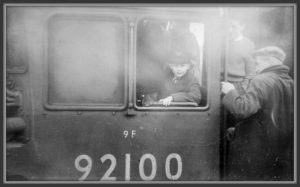
Here I am in the cab of a Class 9F 2-10-0 (“Decapod”) loco. This particular engine is one of 251 examples of the class, which were intended for heavy freight duty, and were the last steam locomotives designed and built for BR (British Railways). The first example, #92000, entered service in 1954. One of the class, #92200, entered history as the final steam locomotive to be built for BR (the numbers were not allocated strictly according to date of build). Named Evening Star, it was built in 1960, but even it succumbed to the steam phase-out and was withdrawn in 1965. Fortunately, it had been earmarked from the start for preservation, and had a green livery normally reserved for passenger locomotives, somewhat reminiscent of the old Southern livery, whereas all other 9Fs were painted black (and were not named). Evening Star did see some passenger express work and was clocked at over 90mph, even though she was built for heavy freight haulage.
There is a slight Christmas link associated with my visit to 92100, because it was while waiting for the bus at the start of the trip that my father inadvertently blew-away the last faint shred of hope I still had that Father Christmas was real!
I still have an Airfix plastic kit model of Evening Star that I made about 45 years ago, along with a cement truck and a guard’s van (aka caboose).
Unfortunately, just after we bought our condo here at Lansdowne Woods but before we had moved in, this model was left in a small glass display on our enclosed balcony during the summer, and became so hot that the plastic of the boiler softened and distorted under its own weight, with the result shown! This model is to HO/OO scale (1 inch = 6 feet), which was the preferred scale for electric toy trains when I was a kid. (This model is not motorized.) Just as electric traction replaced steam in real life, in the toy train world electric traction sounded the death-knell for clockwork power.
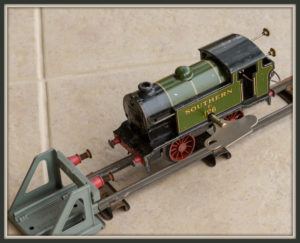
This tank engine is clockwork driven. The winder on the side is, of course, removable, and incorporates across its broad end a clever track gauge checking feature. Like many clockwork trains, this locomotive is in O gauge, which is about twice the size of the HO (“half O”) scale. You will doubtless have noticed from its livery and lettering that this is a semi-scale model of a Southern Railway 0-4-0 tank engine. It is one of the first toys I can ever remember playing with. Until doing some research for this post, I had cherished the belief that it had belonged to my father when he was a child, but I know now that this version (without cylinders or connecting-rods) was only built between 1932 and 1936, making it (and most of my track and some of my rolling stock) too young to have been one of his childhood toys. Nevertheless, it still has great sentimental value to me, and I am thrilled that this Christmas it is running around a track under our Christmas tree.
In the same late-1950s timeframe I have talked about above, for one Christmas my sister and many of my aunts and uncles – real and honorary – gave me rolling stock and track accessories. I have treasured these over the years, and they even crossed the Atlantic with me, but I think this is the first time I have set them all up together for probably 50 years! It was an interesting exercise to get them all set up under our Christmas tree (much bigger this year!) without totally taking over our living space!
With the exception of the passenger coach seen here with the Southern tank engine, all the other rolling stock was made by the Hornby company. That British institution was started by Frank Hornby, who also invented Meccano (the British fore-runner of the Erector Set), and manufactured the Dinky Toys line of die-cast cars and aircraft. The layout shown above includes several of my childhood Dinky toys, all of which have sacrificed their pristine appearance to long hours of play.
For those of you who are train buffs, I apologize that the track layout shown is totally impractical from a real operating point of view. For airplane buffs, I am sorry that the Dinky Toy Supermarine Swift jet fighter shown loaded onto the red/blue Dinky lorry (aka “truck”) is hopelessly out of scale! And I apologize to my infinitely-patient and supportive wife, Ruthi, for not having tidied-up more of the “clutter” before taking the pictures!
Have a wonderful Holiday Season!
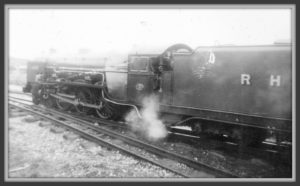

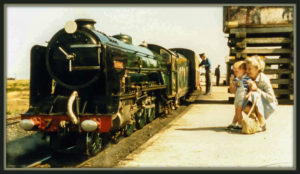
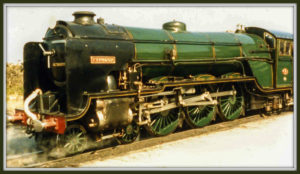
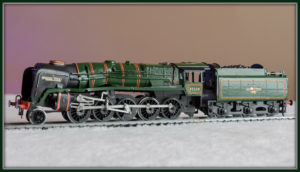

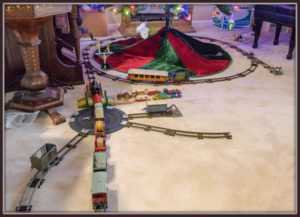
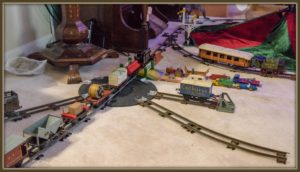
3 thoughts on “Christmas Trains”
So lovely to see the train set out again…it brings back so many happy memories!
I hate to argue with my learned brother, but I was always told it was he who confused the name of the RHDR!!!
Actually, she loves to argue, but she is probably correct!
Thank you for sharing!
I love the trains and I want to show my granddaughter the LEGO
Train. She is 11 and is quite the LEGO builder.
You and Ruthi have adorable grandchildren.
Comments are closed.